Medieval Villages Galore
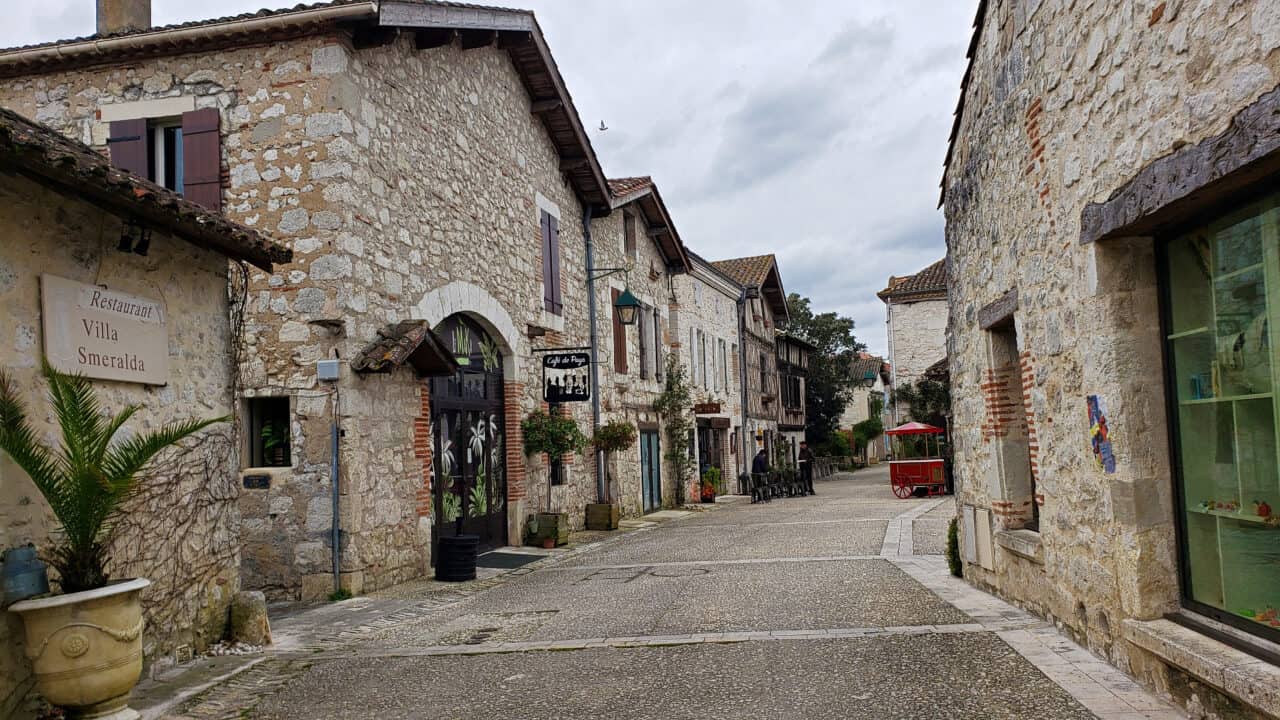
I think what intrigues Mike and I the most about the various medieval villages we have been touring is that you will never see anything close to this in the US or Canada, our countries just aren’t old enough to have medieval history. What is also fascinating to us is how these very old villages have been adapted to the modern age. These are not just tourist sites, they are homes and businesses where people live and work. Here are just a few of the villages we have been visiting both by bike and by car.
Fourcès is a medieval village that used to have a castle that was destroyed in the 15th century. What makes that noteworthy is that the site of the castle then became the town square. It was quite interesting to read, before visiting, about the town having a circular square. Sorry to my friends who don’t have English as a first language. This square is surrounded by 17 th and 18 th centuries houses, arcades and half-timbered houses as well as a 13th century clock tower. The locals meet in the square to play boules.
Larressingle is a medieval village in the middle of fields of grapevines. The homes in Larressingle are made from golden stone often with preserved mullioned windows. The houses surround a castle-donjon and the prerequisite old church. Mike and I are learning new English words as we travel in foreign lands. A donjon is a massive inner tower in a medieval castle. It isn’t a dungeon, which it sounds like, but they were sometimes used for a similar purpose. Mullioned windows have vertical strips of stone or wood between the window panes which are usually just for decorative purposes. OK, so maybe some of you knew what these words meant but I didn’t.
We had lunch in the French village of Montréal. Not only does Canada share city names with France (and many other European countries) but the names are reused multiple times within France. I was trying to highlight Montréal on my map of France as it was listed as one of the most beautiful villages in France, which is a specific French designation. I accidentally marked the wrong Montréal. To alleviate some of the confusion you will often, but not always, see the name of the area or a significant geographic feature that is nearby appended to the town name. If we did this in Canada one might say Montréal-of-Quebec or Montréal-above-St. Lawrence.
Montréal du Gers, founded in 1255, is a bastide town which were the new towns of the 13th century. It feels really strange to write the word “new” and “13th century” in the same sentence. Anyway, a bastide town usually has a central square that is surrounded by arcades with large stone arches. The streets radiating out from the square are typically straight and I read that they were carefully planned to give equal space to each house. I can’t say that I noticed that. The homes here were the half timber houses, which are like the Tudor style that we see at home. Nowadays the arcades around these squares usually contain cafés and restaurants, like you would find on a tourist street at home. Montréal’s most well known site was a 4th century villa paved with more than five hundred square meters of ancient mosaics. We would love to have seen this but it wasn’t open the day we were there.
I will say that Mike has been really impressed with the cleanliness of all these old towns. While we were moving the RV to a new campground we got a little closer to the centre of this small town than we really liked. Our RV GPS was correct. Our camper did fit and we were directed around the actual centre of the town but I would really rather avoid medieval towns completely with the RV.
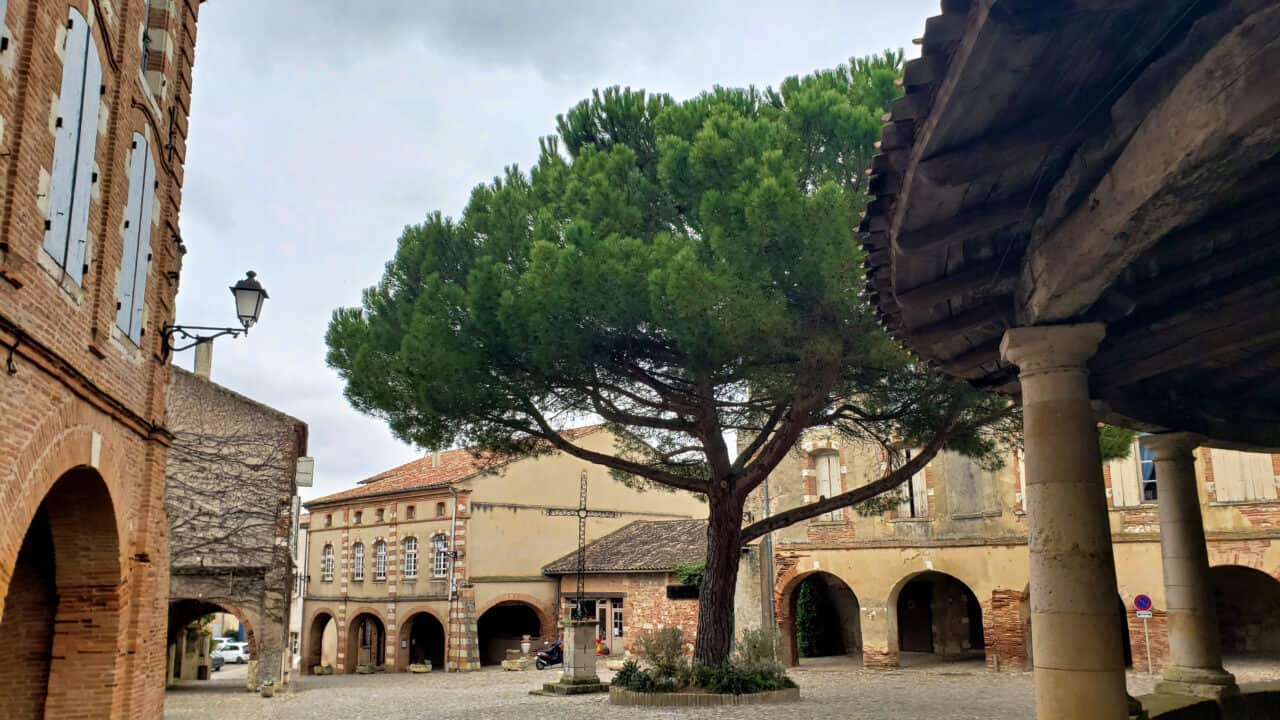
After Montréal we stopped and tried to get a drink in the town of Condom. The name actually comes from two very long words that were combined and shortened a little and then a few centuries later shortened a little more and then compressed again until they finally got “Condom”. Although the town name has nothing to do with the English equivalent word, in 1995 the town’s mayor decided to take advantage of the similarity and he opened a museum of contraceptives. 10 years later the museum closed.
Very common here is the production of a liqueur that I have never heard of “Armagnac”. Apparently it is a distinctive brandy. Hopefully I will get a chance to try Armagnac before we leave without having to buy an entire bottle that would probably go to waste.
The picture below is of the Four Musketeers (including D’Artagnan) and my husband as the fifth. This large statue stands beside the main church in Condom. Not only does Europe have lots of ancient statues, they continue to create new ones. This one was built in 2010. Can you tell that I love statues 😊. I wish we had more of them all over North America.
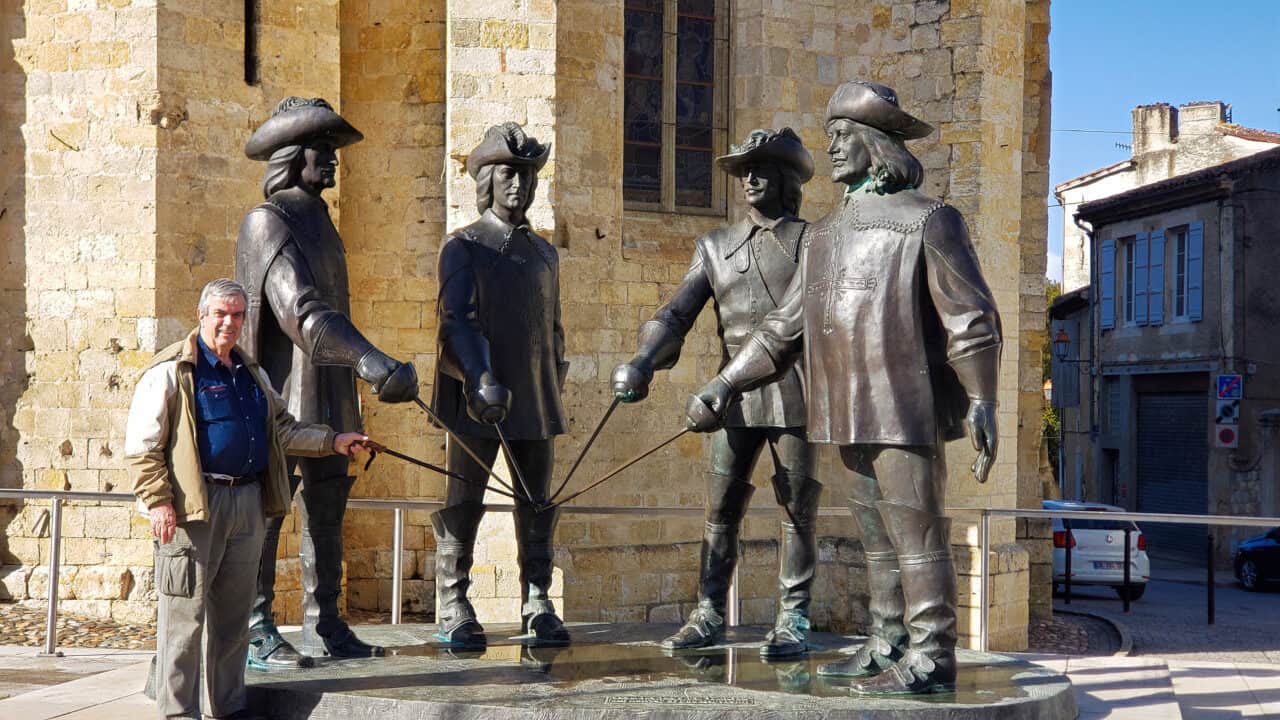
In Croatia you could find pasta restaurants almost anywhere where there were tourists. In France so far, it appears to be pizza restaurants. We did make it to one restaurant on time. The hours that it was open Monday – Saturday were noon till 1:30 PM and 7 PM to 9 PM. These hours are the norm here. Even when Mike and I manage to arrive on time for lunch we often don’t get in. Because the hours are so compressed the restaurants are full and often require reservations even for a quick lunch. We could starve in this country! I don’t enjoy riding 40 km without at least one proper break and preferably two. After 1:30 PM you can’t even get a drink at most of these places. They are closed up tight until 7 PM and by then Mike and I are back in our camper for the night. This is probably my biggest problem with France so far. The other issue is that they don’t know how to make a cappuccino and they certainly don’t know how to make good foam. That might be why whipped cream is so common to have in place of foamed milk.
The hours aren’t the only thing that surprises us at restaurants. The other day we saw “faux-filet” on the menu. Now what would you think that is? Our assumption was that it was a vegetarian version of a steak. We were wrong. It actually meant real Sirloin steak. In one restaurant where the waitress didn’t speak any English at all two tables were trying to help us with our French translation. These customers also didn’t have much English but it was a lot of fun. In most of Europe Menu means the daily special. It is often a very good deal and can include appetizers, main course and desert.
Within France, fully vaccinated means three shots. France has now removed the requirements for vaccine checks and masks in most places. Before the restrictions were lifted Mike and I were initially refused entry into one restaurant because our French proof of vaccine was from last year when we only had 2 doses and they couldn’t read our Canadian QR code to prove our third dose. The Canadian paperwork didn’t help any. Even though the requirements have lifted Mike and I decided to pay and get the French equivalent certificate to our Canadian one. The certificate or vaccine passport is good all over Europe. We probably won’t ever need it but I like the security of having it. In France you still need masks on trains and public transportation as well as seniors facilities. When we were trying to get this equivalency certificate we were having a bit of a language problem with the pharmacist. Doesn’t one of the people in line behind us turn out to be a Canadian from Vancouver. He and his wife used to spend six months a year in this area and have now moved here full time. He was fascinated to see our car with Ontario license plates and he helped us a lot. He did mention that he had been to see his doctor that day and still had to produce his vaccine passport to get in.
We were lucky that the pharmacy was open when we arrived. Like restaurants have very stringent hours so do many of the businesses including retail. They often close for lunch and don’t open again until 2 or 3 PM. I don’t know how anyone manages to run errands or pick up a prescription during their lunch hour.
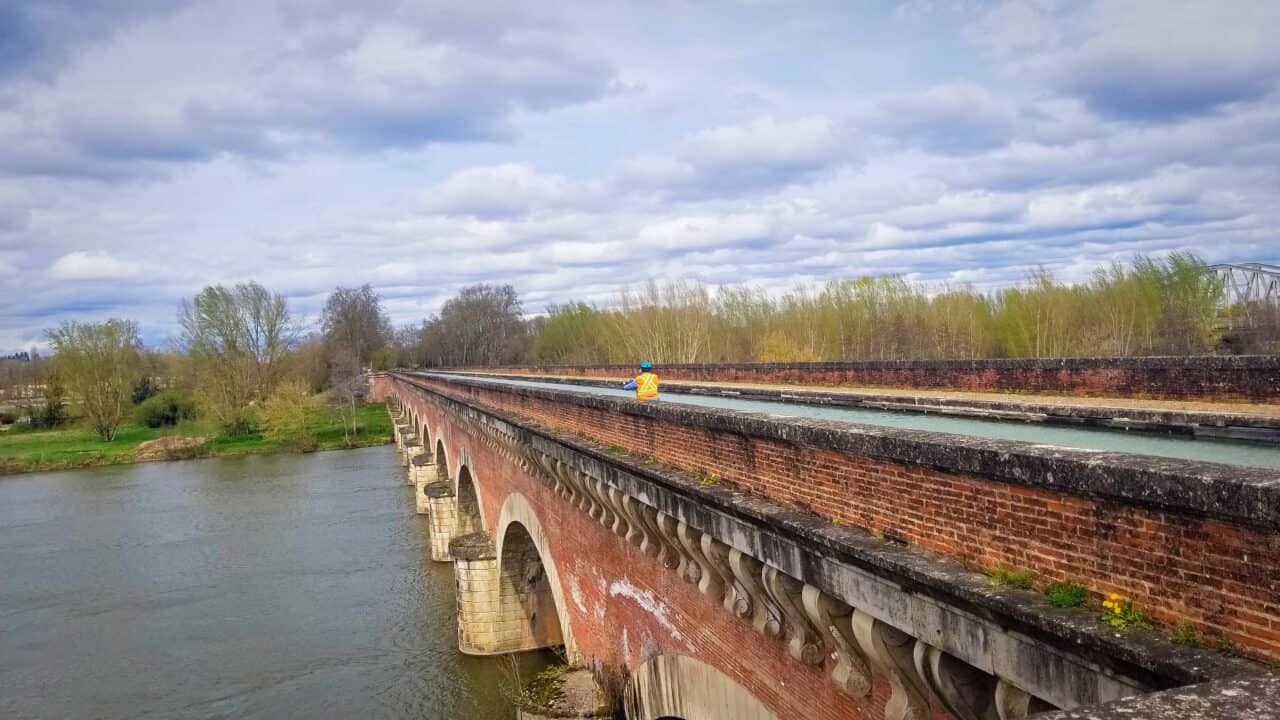
We have been taking our cycling easy for the first few weeks. One year we started out immediately on our 40 km rides. Doing three of these rides in three days after not riding for months bruised my seat quite badly. We then had to completely avoid the bikes for a while. This year I am working up to 40km slowly. For anyone new to reading this, our bikes are ebikes. This makes the pedalling easier but doesn’t help the comfort of your backside. We are mainly riding on a 750 km (almost 500 miles) bike path from the Atlantic to the Mediterranean called “Le Canal des 2 Mers à vélo” or “Canal of the 2 Seas by bike”. Above is a photo of me riding on the canal path as it crosses above the river Tarn near the town of Mossaic. It was great. A few days earlier we had crossed the river Garonne going into Agen on an even higher and longer aqueduct.
One of the things that we have noticed on our rides are the number of greenhouses all around. I can’t get over seeing all the fields that have large scale irrigation equipment in them. Based on the rain last fall, this winter and now this spring, it is hard to believe that irrigation is ever needed! We haven’t been here in a summer yet this trip. The grass is really green everywhere, presumably due to the rain. Each day the trees seem to be getting a little greener and we just saw our first magnolia trees this year. For our friends north of Toronto – you will see spring sometime this year – Honest!
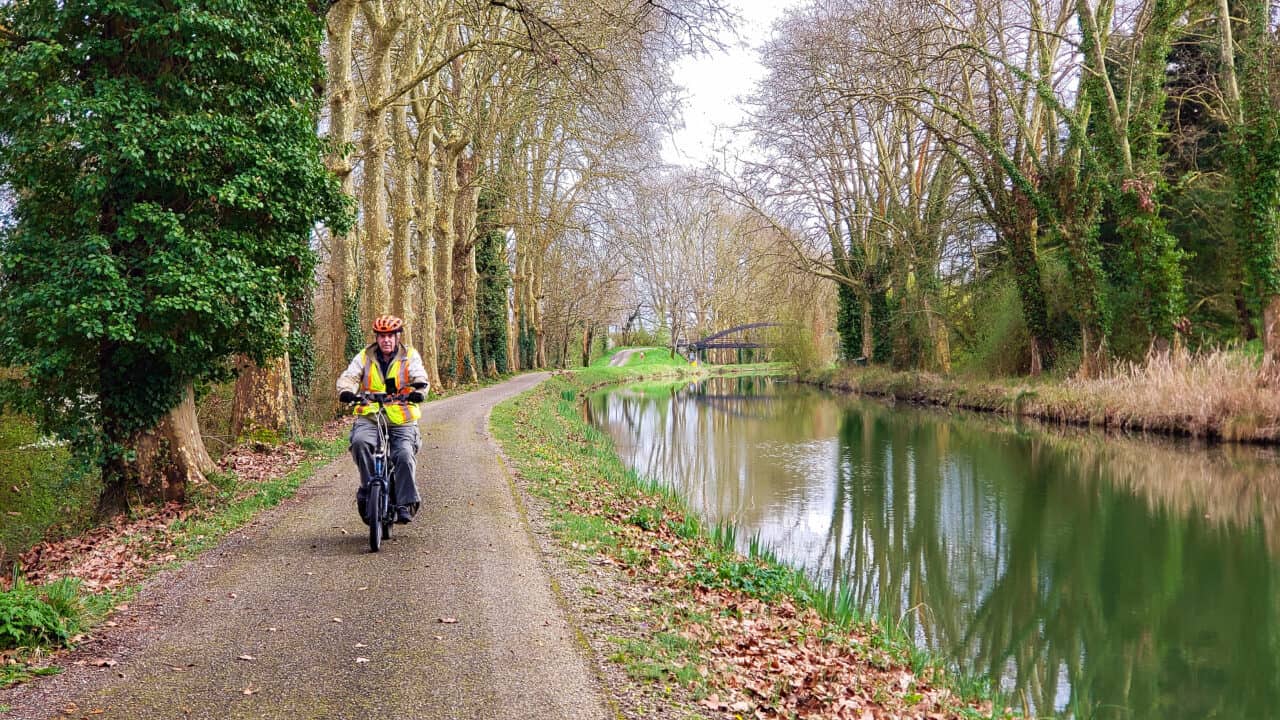
Although many countries have gone to electronic tolls on the major roads, France has not. With the electronic tolls or stickers you pay ahead of time. For cars it is a flat monthly rate regardless of usage. Although we weren’t very happy with the prices of the automated system, especially when we avoid highways most of the time, it turns out that there were some advantages. In France, since you need a toll booth and toll collectors at every highway exit, that means that the exits are few and far between. This sometimes makes it awkward when you are staying on one side of the highway and really want to get to the other side.
We are still continuing to stop in and view many churches. It often feels like we are going into art museums. The paintings and the sculptures are fascinating.
Mike and I were looking at pictures of Ukraine recently. It looked just like the type of country where we would have loved spending our time in on this journey. I am really sorry that it didn’t happen and that many, many of the architectural highlights will be gone forever. Buildings and artwork from cathedrals like the one below that we visited this week, may never be seen again. I must admit that we are quite glad that we just finished our Central European portion of this tour and are now on the far western side of France. That worked out well for us. Like everyone we know we are wishing the best to the people of Ukraine.
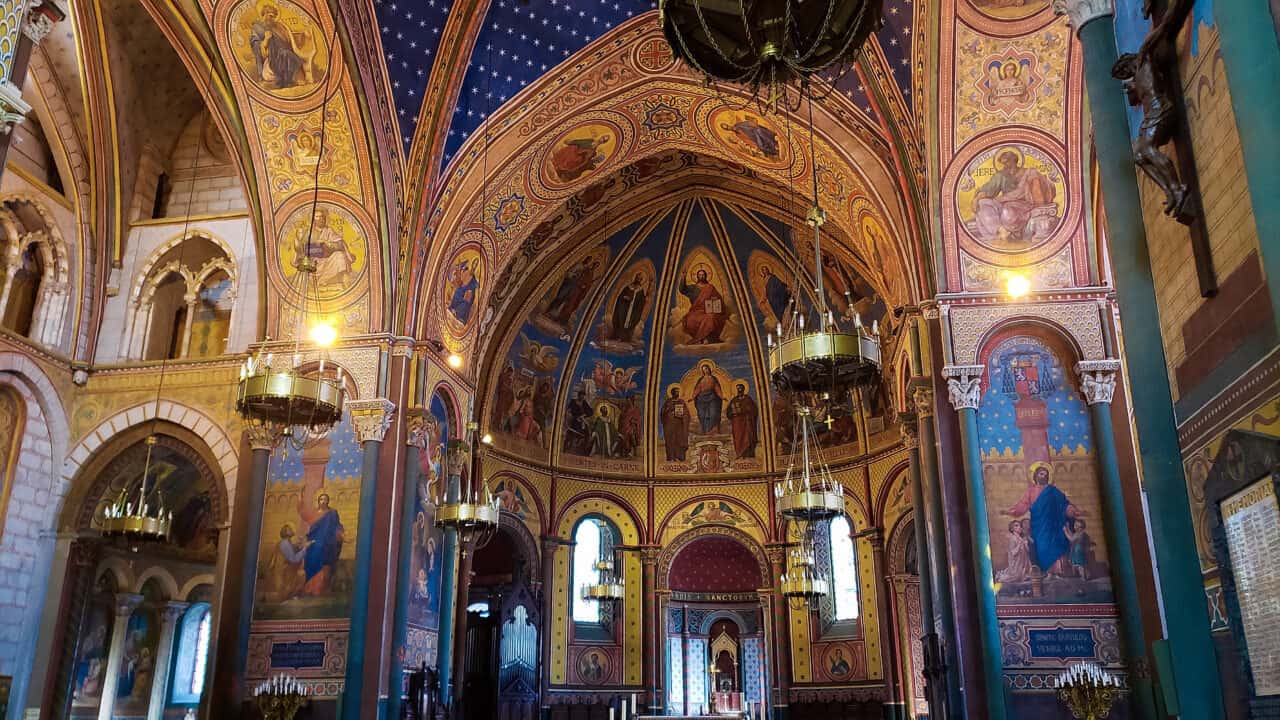

Leave a Reply